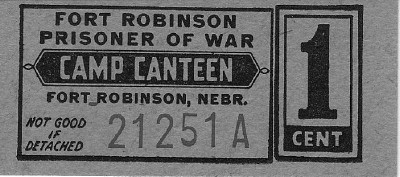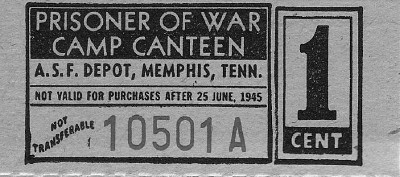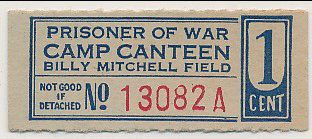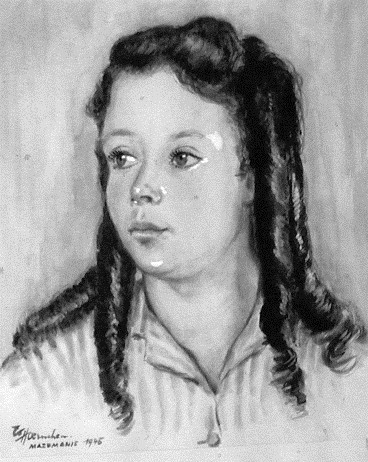
NOW Articles Written By Members
A look back at a common, but classic commemorative – Wisconsin’s Territorial Centennial
A side-tracked story: Mardi Gras Doubloons
A look back at a collecting specialty – the O.P.A. ration tokens of WWII
Bullion And Coin Tax Exemption – Act Now!
Is There A Twenty Cent Piece We Can Add To A Collection
Capped Bust Half Dollars: A Numismatic Legacy
U.S. Innovation Dollars: Our Most Under-Collected Coin?
My 2023 ANA Summer Seminar Adventure
In defense of the American Women's Quarters
A look back in numismatic history – the Hicksville Silver Dollar Hoard
The proofs so few of us collect: Jefferson Nickels
A look back in numismatic history – a story too good to be true
Kilroy promotes war bond sales
Just passing through a short-lived bank
The Kewaunee Line Encased Coin Folder
Lyman C. Draper: Collector, Historian, Genealogist
>> More articles in the Archive
For more NOW Articles Written By Members,
<< More articles in the Archive
POWs in Wisconsin
[by Phyllis Calkins]
Many people probably believe that for America, World War II was fought on distant shores, but for many Americans, it was as close as their own backyard.
In 1942, a rumor had been floating around that Hitler planned on doing an airdrop of weapons to his soldiers being held in prisoner camps in England. To house prisoners in Europe would have required large installations that would have taken thousands of our own troops to guard and they would have been vulnerable to enemy attack. That fear led to America reluctantly agreeing to take charge of prisoners captured after 1942 as a favor to England. The military believed it would be better to transport the POWs back to the United States on the same ships that brought our troops to Europe.
German and Japanese POWs were brought to America by the thousands with approximately 20,000 housed at the main camp at Camp McCoy and the 38 branch POW camps around the state.
The military assumed that many people would be unhappy, even fearful to know that prisoners were located nearby. Little media was reported about the camps but it was impossible to keep it entirely secret. Local citizens were warned to stay away from the camp and were told “These men are prisoners of war and are of no concern to the public. They are under direct supervision of the army and the community should ignore them.” With the extreme lack of manpower left in towns due to the war, the new influx of potential workers was a golden opportunity.
Labor Shortages at Home
The prisoners didn’t just while away their time playing cards, listening to the radio or reading. No, they were put to work. While our men were of fighting in Europe, they were taken to factories and fields throughout Wisconsin and other states where they took the place of our missing workers.
Prisoners were responsible for camp upkeep and maintenance and under the Geneva Convention enlisted men could also be required to work as long as conditions were safe and the work had no direct relation with war operations. In addition to the 10 cents daily allowance prisoners received for personal needs, the War Department paid workers 80 cents a day from the wages collected from employers – roughly equal to an American enlisted man’s starting monthly pay. The War Department used the rest of the wages to defray the cost of housing, transporting, securing and feeding the prisoners. Some camps even turned a profit.
At first POWs were assigned to conservation projects, road maintenance and utility work at military installations or hospitals. During the summer of 1943 private employers were invited to contract prisoner labor. Most prisoners were eager to get out of camp, earn a bit of money, and interact with Americans.
By the end of the war, nearly 96% were participating in the labor program. Their labor proved invaluable to numerous ranchers and farmers who could not have stayed in business otherwise.
Branch Camps
Branch camps, unlike the larger and permanent base camps were only occupied when work was available nearby. Only German POWs were allowed to work from the branch camps. The Japanese and other POWs worked only at base camps.
The military provided each prisoner a meal and the employer provided the water. Determined by the work situation and proximity to the base camp, lunch might be a simple sack lunch carried by the prisoner or more elaborate soup or stew brought to the work site from the camp kitchen or sometimes local restaurants provided the meals.
It was at these branch camps that citizens became aware of what was taking place. Not only did they observe prisoners in their communities, but often worked side-by-side with them. Security varied with some camps. Some tried to segregate the prisoners from civilians and using many guards. In other cases the atmosphere was more relaxed, though always vigilant as to the protection of the citizens.
Some employers had unique incentives to increase the work of the POWs. The McKay Nursery near Madison provided a hearty breakfast each day before the hard work of digging out and wrapping tree root balls began. The Libby plant of Hartford provided a piece-work inventive by punching a ticket for each kettle of beets sliced. A completed ticket earned a pack of cigarettes.
Because of Wisconsin’s great agricultural needs, we had 3 times more POWs in the fields than Minnesota. The camps were located primarily next to fields that needed working, factories in need of workers or on fairgrounds close to both.
The POWs were largely credited with saving the crops during the 1944 and 1945 growing seasons. Without them, the work could not have been accomplished.
It was economically a good deal, both for Wisconsin and the federal government. Private companies contracted for the labor and paid the military 55 cents per hour per prisoner working for them. In turn, the military paid them 80 cents per day in scrip. The rest went to the U.S. treasury.
The military had three options to deal with insubordination. These included a “no work, no eat” policy which restricted their diets to not less than 18 ounces of bread a day and unlimited water. Usually they were back on the job in short order. A new pay system instituted in the spring of 1944 permitted the War Department to pay slackers less and reward hard workers with up to $1.20 a day.
Security was far from rigorous at branch camps and work sites. Army regulations called for one guard for every 10 POWs and the requirement loosened further as the war in Europe neared an end. It became common to find one guard (or none at all) supervising a field full of prisoners picking cotton or harvesting the crops. Stories were not uncommon of guards sleeping on the job or asking prisoners to retrieve weapons left in the field.
The army’s main concern about the work program was fraternization between POWs and female civilians, and with good reason. Illicit romances were common at factories where prisoners and American women often worked side-by-side.
Comfortable Camp Life Discouraged Escape Attempts
Most prisoners thought it foolish to escape from a place where they were enjoying good food, relative freedom and good care. The rate of escape attempts was less than 1%. Those that did attempt to break out typically had mundane reasons – boredom, depression or a Dear John letter.
Barter -- Early Camp Economics
The early economic activity in many camps began as direct barter – one good or service directly traded for one or more of another. Over time, the level and rate of trading increased significantly. Rough scales of trade evolved. A tin of jam was worth a pound of margarine plus something else.
A cigarette was worth several chocolate items and a tin of diced carrots was worth almost nothing.
Over time, as the camp economy became more developed and complex, bartering became very complicated. Eventually, a unit of account and medium of exchange evolved.
Credit (being able to use something today and pay for it later) also evolved in the camps as did spot and future markets. Spot and future prices meant goods could have a certain price if bought today and another price if you wanted to establish an agreement today and buy it in the future.
Changes in the quantity of cigarettes altered prices in the camp. If the quantity of cigarettes went up, prices rose. If the quantity declined, prices fell. Some of the cigarettes were used for smoking and less were available as currency, prices of various goods and services declined, that is, deflation occurred. On the other hand, when new issues arrived and the supply of cigarettes shot up, so did prices. Higher prices would prevail until the supply of cigarettes was again reduced through smoking.
The prison camp economy showed that the quantity of money (cigarettes) primarily affected the prices at which transactions for goods and services took place. The production and availability of goods and services were largely determined by other factors.
Canteen Money
To accommodate the captured prisoners, camps had their own form of currency.
Not only were the states’ militaries responsible to give these people places to live, but also to keep them relatively healthy. Along with housing, medical quarters and general work to keep them busy, canteens were a part of daily life.
 When cigarettes were not being used as currency, canteen scrip were used as the medium of exchange for personal items such as toothpaste, razor blades, stationery and reading materials, tobacco, candy and limited amounts of beer or sake’.
When cigarettes were not being used as currency, canteen scrip were used as the medium of exchange for personal items such as toothpaste, razor blades, stationery and reading materials, tobacco, candy and limited amounts of beer or sake’.
The scrip was usually printed on low quality paper and often made by the prisoners themselves.
My internet search for Wisconsin canteen scrip was unsuccessful. To my knowledge metal tokens were not used because each camp had its own scrip currency which needed to be worthless in case of an escape. An escaped prisoner could not get far with prison scrip, but could last much longer out in the community with real currency.
 The appearance of camp money obviously depended on the camps and on the issuing country. Most US issued camp money was very simple. Each ticket had a serial number, the camp’s name and number and denomination. The camp money was rationed out by the camp authorities.
The appearance of camp money obviously depended on the camps and on the issuing country. Most US issued camp money was very simple. Each ticket had a serial number, the camp’s name and number and denomination. The camp money was rationed out by the camp authorities.
Even the smallest and most temporary camps produced scrip.
POWs stayed at Billy Mitchell Field
Mitchell Field, on Milwaukee’s far west side, became a temporary home for many POW’s. Permission for the War Department to house the captured Nazis at the airport was obtained from the County Board in January 1945. The county leased the airport to the government for $1 per year. In subsequent months, additional prisoners came, swelling the ranks to more than 3,000. Fifty US Army officers and 250 enlisted men operated the camp.
A 1975 Milwaukee Journal newspaper article reported German Prisoners of War assembled batteries in a workshop at Mitchel Field.
“Achtung” the sergeant shouted. Scores of men woodenly upright clicked their heels and cried out in unison “Guten Tag”. It looked a little like a classroom scene with the pupils chorusing “Good Morning Teacher.”
The sergeant and his fellow German soldiers marched from their barracks to join hundreds of other military compatriots in adjacent barracks to work on two battery assembly lines. In all there were about 1,500 of these heel-clicking, goose stepping men assigned to the World War II work project.
They volunteered to assemble batteries for use in training US army soldiers. A shortage of civilian workers and the critical need for batteries to train Army soldiers in this country promoted the War Department to approve the voluntary use of POWs on two battery assembly lines set up in a hanger at the field.
Prisoners were paid an equivalent of 80 cents per day – not in cash, but in canteen coupons, which they could spend for cigarettes, candy and beer. By doing so, they broke the monotony of having nothing else to do, and in effect hastened the end of the war.

A very rare BILLY MITCHELL CANTEEN TICKET from the collection of Tom Casper.
Although security at the field was rigid and the compound was surrounded by barbed wire, two POW escaped for a short time. Two police officers stopped them and when the suspects were asked for their draft card and they replied “Vass dat?”, the prisoners were returned to army authorities and they thanked the policemen for their kind treatment. The camp closed on April 1, 1946.
Lasting Friendships
Many POWs developed friendships with their employers, some of which persisted into peacetime.
An extraordinary level of trust and friendship developed with many POWs and their employers. They filled an obvious need, but to many families they did not seem like strangers. This familiarity led to many acts of kindness and generosity.
Prisoners were frequently invited to the dining room table for a meal with the family. Housewives often added cookies, cake or other food to supplement the sandwich that POWs brought to the field for their lunch.
One family trusted their POW around their children, even sending him out on a pony to pick up their daughter from school. Another let one of his workers go hunting unattended with shotgun in his pasture. His trust was rewarded when the POW brought back 10 rabbits for the stew pot.
In Germany a farmer who owned 2 cows was considered wealthy. Near one of the camps was a farmer who owned 30 cows. The cows amazed them. The POWs would go outside during their break and sit and just watch the cows.
Closer to Home
A Mazomanie Connection…
At a meeting of the Mazomanie Historical Society, we learned that in 1945 German POWs from the Lodi camp were bussed daily to work at the Sparks Pickle Company in Mazomanie.
In 2003, just by coincidence, Barbara Olevsky Beck from Illinois visited the museum to donate photos and a copy of a watercolor portrait of herself painted during her family’s time at the farm near Mazomanie. Barbara recalled that prisoners were bused in and worked in the factory until they were returned to Lodi each evening.
 Barbara recalled her father felt sorry for one of the prisoners as he was old and they felt it might be too hard for him to work in the factory. He was an artist, spending his time in the hayloft painting many portraits and scenery, using watercolors. The painting of herself was signed by “W/Hoernchen, Mazomanie 1945.” In 2011 another painting was donated to the Mazomanie museum -- also signed by the same artist.
Barbara recalled her father felt sorry for one of the prisoners as he was old and they felt it might be too hard for him to work in the factory. He was an artist, spending his time in the hayloft painting many portraits and scenery, using watercolors. The painting of herself was signed by “W/Hoernchen, Mazomanie 1945.” In 2011 another painting was donated to the Mazomanie museum -- also signed by the same artist.
The Mazomanie Historical Society’s 2003 annual meeting featured Betty Crowley, author of “Stalag Wisconsin”. Several of the illustrations in her book were by a POW W. Hoernchen. Betty’s book took her 3 years to research and recounts many details of the Prisoner of War camps in Wisconsin.
The Lodi Enterprise reported that twelve German POWs and their American Guard were injured when the truck in which they were riding tipped over. The prisoners had been working at the Sparks Pickle Company in Mazomanie and were being returned to the Lodi camp. All were rushed to Truax for treatment.
After The War
By the end of the war German prisoners had been housed at more than 900 facilities scattered across the nation leaving an indelible mark on the home front.
The labor program, in addition to keeping POWs mostly out of trouble, provided an infusion of some 200,000 workers that helped alleviate the severe labor shortage in the United States and helped free thousands of Americans to serve in the armed forces and work in the war industries.
The prisoners were so essential to agriculture that for the 1945 harvest, President Harry S. Truman gave in to pressure from growers and delayed the repatriation of Germans who had been contracted out to harvest sugar beets, cotton and pulpwood.
So important were the prisoners to the labor force that many of them stayed until 1946, the year after the war was over. The employers needed them and many POWs did not wish to go home. In some cases their towns had been destroyed, their families scattered or killed. In other cases, they simply saw a better life for themselves in America.
The process of repatriating POWs and shutting down the camps was done for the most part by the end of 1946. Shortly before their actual departure the prisoners received their personal belongings that had been seized upon arrival in the U.S. and stored in individually sealed bags. They also redeemed any balance in their trust-savings account. Restricted from taking American currency with them, they received government checks for the amount saved. American authorities in Europe and Asia cashed these checks upon presentation. Most POWs went home with a sizable sum of money that helped not only them and their families, but the European economy as well.
Although required to return home to Germany, many returned and settled in Wisconsin. It’s impossible to calculate the full effect the POW camps had on the cultural and economic well-being of our state. It’s just as impossible to know exactly how the ripple effects from those camps go on today.
World War II camp money is an immense topic with hundreds of issues from World War II and each issue has an individual story behind it.
Recommended resources: ‘STALAG WISCONSIN, Inside WWII prisoner of war camps’ by Betty Cowley, Badger Books 2002. Thanks to Tom Casper for use of his Mitchell Canteen ticket.
Have an interesting numismatic topic you’d like to share with your fellow NOW members?
Send your article to evan.pretzer@protonmail.com today!!!